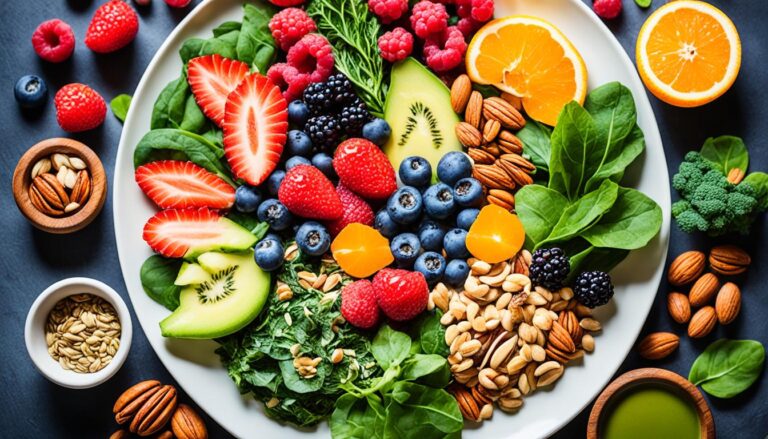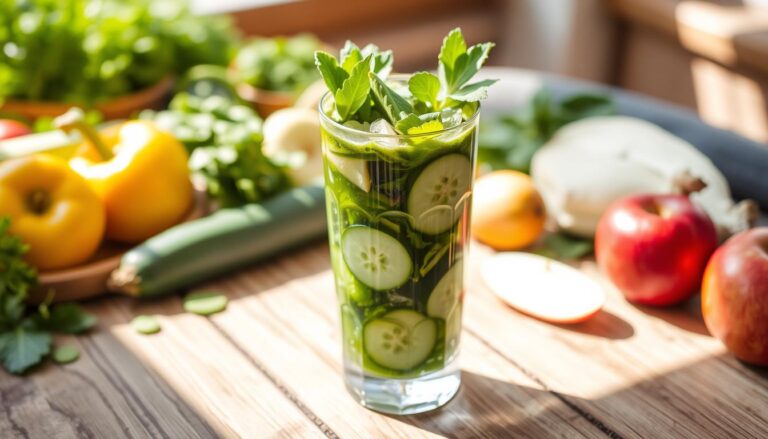Do you know how much meat you should eat daily? The American Heart Association suggests 2 servings, or 6 ounces, of lean meat a day. This is for a 2,000-calorie diet.
But what does 2 servings of meat look like, and why is it key to know the right portion sizes? Explore this quick guide to learn about meat servings and how to add them to a healthy diet.
Key Takeaways
- The recommended daily intake of lean meat is 2 servings or 6 ounces.
- One serving of meat is equivalent to the palm-sized portion, which equals 3 ounces.
- Portion sizes of food consumed outside the home have increased significantly over the years.
- Understanding proper serving sizes is crucial for maintaining a balanced diet and meeting nutritional needs.
- The Nutrition Facts label can help identify nutrient-dense and lean protein sources.
What is 2 Servings of Meat?
The American Heart Association says to eat 2 servings, or 6 oz., of lean meat daily. One serving is like the size of your palm, which is 3 oz. This advice comes from the Healthy Eating Food Pyramid. It tells us to eat a moderate amount of meat, fish, eggs, and their alternatives for health.
Eating just two servings of red meat a week might increase your risk of type 2 diabetes. But, choosing plant-based proteins instead can lower this risk by 30%. Those who ate the most red meat had a 62% higher risk than those who ate the least.
Every extra serving of processed red meat raises your risk of type 2 diabetes by 46%. Unprocessed red meat increases it by 24%. But, swapping red meat for plant-based proteins like nuts and legumes can lower your risk by 30%.
| Protein Source | Portion Size |
|---|---|
| Lean Meat | 3 oz. (palm size) |
| Fish | 3 oz. (hand-size piece) |
| Eggs | 2 eggs |
| Beans/Pulses | 1/2 cup or 3 tbsp |
| Nuts/Seeds | 1 handful |
| Tofu | 1 palm-size piece |
Knowing the right portion sizes of different proteins helps us make healthy choices. We can balance our diet with the right amount of meat and other proteins.
Portion Sizes and Protein Intake
Guidelines for Meat Servings
The Healthy Eating Food Pyramid offers advice on daily food servings. For a 2,000-calorie diet, adults should eat 5.5-8 oz. of meat, fish, eggs, and alternatives daily. At least 5 oz. should come from seafood, nuts, seeds, beans, peas, or lentils.
One ounce of cooked meat, poultry, or seafood is one protein equivalent. It’s important to keep portion sizes right for nutritional needs and a healthy diet.
- MyPlate suggests 5 to 10 ounce equivalents of grains daily for adults.
- Adults should aim for 5-7 ounce equivalents of protein daily.
- A protein serving is 2 to 3 ounces, like the size of a deck of cards.
The USDA’s MyPlate guideline advises half your plate for fruits and vegetables. It also recommends 3-4 ounces of grains, 5-6 ounces of protein, and 3 cups of dairy daily for adults.

It’s key to ensure the right portion sizes of meat and other protein sources. This is vital for meeting nutritional guidelines and a healthy diet.
Measuring Meat: The Palm Technique
Finding the right portion size for meat can be tricky. But, there’s a simple trick to make it easier. The “Color Me Healthy… preschoolers moving and eating healthy” guide suggests using the palm technique. It says one palm-sized portion is about 3 ounces, or one serving of meat.
This easy method helps you know how much meat to eat for a balanced meal. You can compare your palm to a measuring cup. This way, you can make sure you’re getting the right amount of lean meat, about 6 ounces, every day.
| Serving Size | Visual Equivalent | Approximate Grams |
|---|---|---|
| 1 Palm of Protein | 3-4 ounces of cooked meat or tofu | 20-30 grams |
| 1 Handful of Carbohydrate | 1/2-2/3 cup of cooked grains or legumes | 20-30 grams |
| 1 Thumb of Fat | 1 tablespoon of oils, nuts, seeds, nut butter, or cheese | 7-12 grams |
Using the palm technique helps you eat the right amount of lean meat. It’s part of a healthy, balanced diet. This simple trick guides you on portion sizes and protein intake for better nutrition and health.
Importance of Lean Protein in a Healthy Diet
Eating well is key for staying healthy. The American Heart Association says to pick lean protein sources. Lean meats, poultry, fish, and seafood are full of nutrients but low in fat and calories. They’re great for those looking to eat right and live well.
Benefits of Choosing Lean Cuts
Lean protein has many benefits:
- It helps build and keep muscle
- It keeps blood sugar levels steady
- It makes you feel full and satisfied
Choosing lean meats helps you get enough protein without too much fat. This is good for your health and follows the MyPlate guidelines. Adults should aim for 5 to 6 1/2 ounces of protein each day, based on age, gender, and activity level.
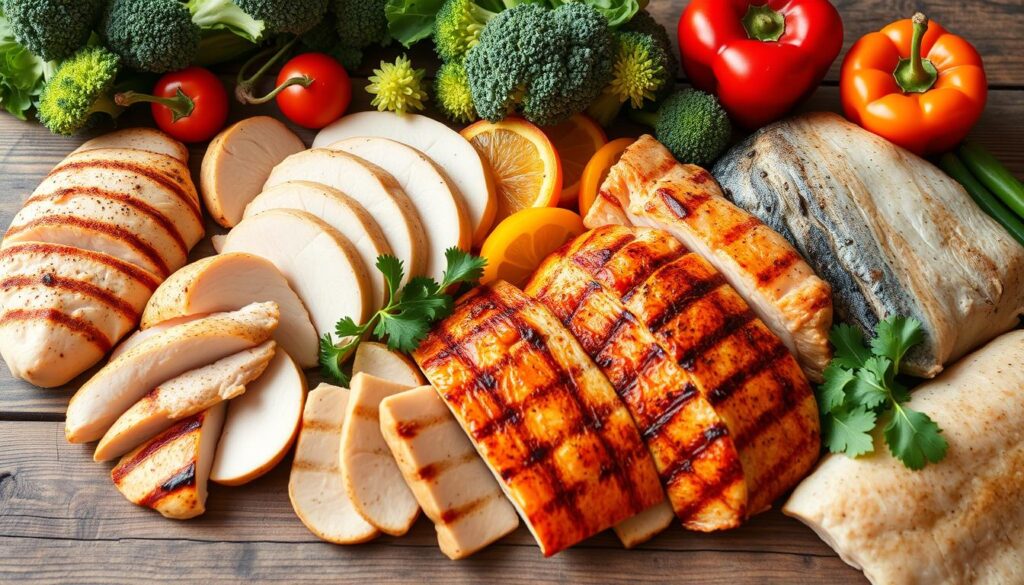
Studies also show eating 8 ounces of seafood a week can lower heart disease risk. Seafood is packed with omega-3 fatty acids. Nuts and seeds, like sunflower seeds, almonds, and hazelnuts, are also good for protein and vitamin E.
“Consuming lean protein can help support muscle growth and maintenance, regulate blood sugar levels, and promote feelings of fullness.”
Adding different lean protein sources to your diet is smart. It helps you meet your nutritional needs and boosts your health and happiness.
Meal Planning with Proper Meat Portions
Adding 2 servings, or 6 oz., of lean meat to your meal plan is key for a healthy diet. The Nutrition Facts label on packaged foods shows the right serving sizes and nutrients.
At home, use the palm technique to measure meat portions. Also, think about side dishes and other food groups when planning meals. This helps make your meals well-rounded and nutritious.
Balanced Meal Composition
A good meal should have:
- Meat/fish
- Vegetables
- Starch
The best plate layout is 50% veggies/legumes/fruit, 25% meat/protein, and 25% whole grains. This mix makes meals nutritious and filling.
Portion Control Strategies
Visual cues can guide portion sizes:
- Palm for meats/proteins
- Closed fist for vegetable portions
- Cupped hand for carb servings
- Thumb size for fat servings
Following these guidelines and focusing on meal balance can lead to healthier meal planning and better nutrition.
Meal Prep Made Easy
For busy weekdays, have a simple food option like rice pilaf, couscous, or potatoes. This makes meal planning easier. You can then focus on preparing the meat and veggies.
By mixing personal taste, nutritional needs, and ease of prep, you can make a lasting and enjoyable healthy diet. It will include the right portion sizes of meat and other foods.
“Portion control is key to maintaining a healthy lifestyle. By being mindful of our meat servings and overall meal composition, we can nourish our bodies while enjoying delicious and satisfying meals.”
Nutrition Guidelines for Meat Consumption
Balancing Meat with Other Food Groups
The Healthy Eating Food Pyramid offers detailed advice on eating meat. It suggests eating moderate amounts of meat, fish, eggs, and their substitutes. It also stresses the importance of eating lots of vegetables, fruits, whole grains, legumes, nuts, and low-fat dairy products. It’s key to balance meat and protein with other food groups to stay healthy.
Guidelines on meat and protein servings differ by country. For example, Belgium says to eat up to 300 g of red meat a week and limit processed meat to 30 g. Denmark suggests about 350 g of meat weekly, focusing on plant-based foods and less beef and lamb. France advises to not eat more than 500 g of red meat a week and 150 g of charcuterie, with each portion being 100 g.
| Country | Meat Consumption Guidelines |
|---|---|
| Belgium | Up to 300 g of red meat per week, 30 g of processed meat weekly |
| Denmark | About 350 g of meat per week, emphasis on plant-rich diet, limit beef and lamb |
| France | Limit red meat to 500 g per week, charcuterie to 150 g weekly, 100 g portion size |
By following these guidelines and balancing meat with other foods, you can meet your protein needs. This ensures a healthy and balanced diet.

Types of Meat and Serving Sizes
Knowing the right portion sizes for different proteins is key to a healthy diet. The Healthy Eating Food Pyramid shows how much of each to eat. One ounce of cooked meat, poultry, or seafood is one protein equivalent.
Here are some examples of one-ounce protein equivalents:
- 1/4 cup of cooked beans, peas, or lentils
- 1/4 cup or 2 ounces of tofu
- 1/2 ounce of nuts or seeds
- 1 tablespoon of peanut butter
- 1 egg or two egg whites
Animal-based proteins have specific serving sizes. A 3-ounce serving of chicken or turkey is like a deck of cards. Red meat servings are about the size of a regular iPhone. Seafood like salmon, tilapia, and tuna have about 120 calories per 3- to 4-ounce serving.
| Protein Source | Serving Size | Calories |
|---|---|---|
| Chicken Breast | 3-4 ounces | 20-25 grams |
| Steak | 3.5 ounces | 310 calories |
| Hamburger | 4 ounces | 240 calories |
| Lamb | 3 ounces | 250 calories |
| Pork Loin | 3 ounces | 206 calories |
| Salmon | 3-4 ounces | 121 calories |
| Tilapia | 3-4 ounces | 114 calories |
| Tuna | 3-4 ounces | 124 calories |
Choosing lean proteins like poultry, fish, and plant-based options helps meet daily protein needs. It also supports overall health and well-being.
Adjusting Portions for Activity Levels
Your protein needs change with your activity level. The Healthy Eating Food Pyramid gives general protein intake guidelines. But, you might need to adjust for more activity or special dietary needs.
Calculating Protein Needs
To figure out your protein needs, think about your age, weight, and how active you are. Talking to a healthcare expert or a registered dietitian can guide you. They can help you find the right amount of protein, including meat, for your health and fitness goals.
Here are some tips to calculate your protein needs:
- First, find your weight in kilograms by dividing your weight in pounds by 2.2.
- Then, multiply your weight in kilograms by 0.8-1.7 to find your daily protein needs in grams, based on your activity level.
- For instance, a 150-pound (68 kg) person who is moderately active needs about 54-116 grams of protein each day.
Adjusting your portion sizes and protein intake for your activity level is key. It helps you keep a healthy diet and reach your fitness goals.
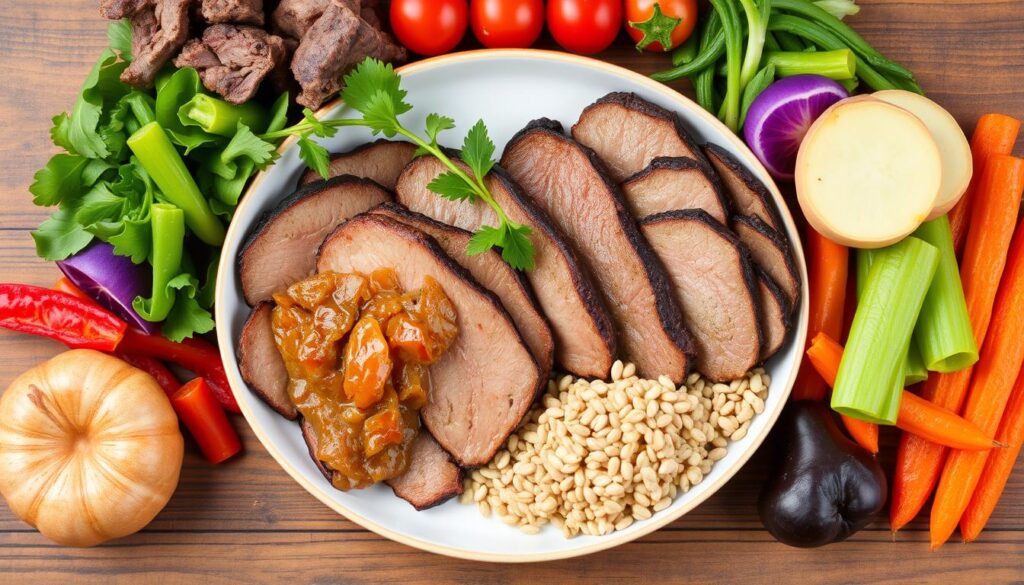
“Proper protein intake is crucial for maintaining muscle mass, supporting recovery, and fueling your active lifestyle.”
Cultural and Personal Preferences
Meat choices are shaped by personal taste and cultural traditions. The Healthy Eating Food Pyramid stresses the importance of a balanced diet that fits individual and cultural food preferences. This ensures long-term health and well-being.
Recent studies show that over 75% of people are unwilling to give up unprocessed red meat or processed meat. More than 80% also don’t want to eat less meat. Men are less likely to stop or reduce meat intake than women.
Meat consumption varies by ethnicity. Blacks eat the most meat, followed by East Asians, Whites, and Hispanics. Blacks eat more chicken, while East Asians prefer pork and processed meat.
Cultural views on meat also differ. East Asians see meat as a festive food and feel less guilty about animal slaughter. Yet, there’s no big difference in how different groups feel about eating meat.
It’s clear that a flexible approach to meat is needed for a healthy diet. Understanding personal and cultural differences helps find a diet that fits each person’s lifestyle. This promotes long-term health and well-being.
| Ethnic Group | Annual Total Meat Consumption (kg) | Perception of Meat as Festive Food | Guilt Regarding Animal Slaughter |
|---|---|---|---|
| Blacks | 64.2 | Average | Average |
| East Asians | 53.6 | High | Low |
| Whites | 46.9 | Average | Average |
| Hispanics | 35.8 | Average | Average |
“The diversity of personal preferences and cultural influences highlights the need for a flexible and individualized approach to meat consumption as part of a healthy diet.”
Tips for Controlling Portion Sizes
Keeping portion sizes right is key for a healthy diet and well-being. Use the palm method to gauge meat servings. One palm-sized portion is about 3 ounces or one serving. Being mindful of portions helps meet protein needs and boosts health.
Mindful Eating Strategies
Mindful eating helps control portions and choose better. Here are some tips:
- Listen to hunger and fullness cues to avoid eating too much.
- Serve snacks in bowls, not directly from the bag, to manage portions.
- Use smaller plates to make food look like more.
- Choose fruits and veggies over high-calorie foods.
- Wait 20 minutes before having seconds to check if you’re still hungry.
- Read food labels to know the right serving sizes.
- Ask for smaller portions when eating out to avoid too much food.
These mindful eating tips help control portion sizes and keep your diet balanced. They ensure you get the right amount of protein and other nutrients.
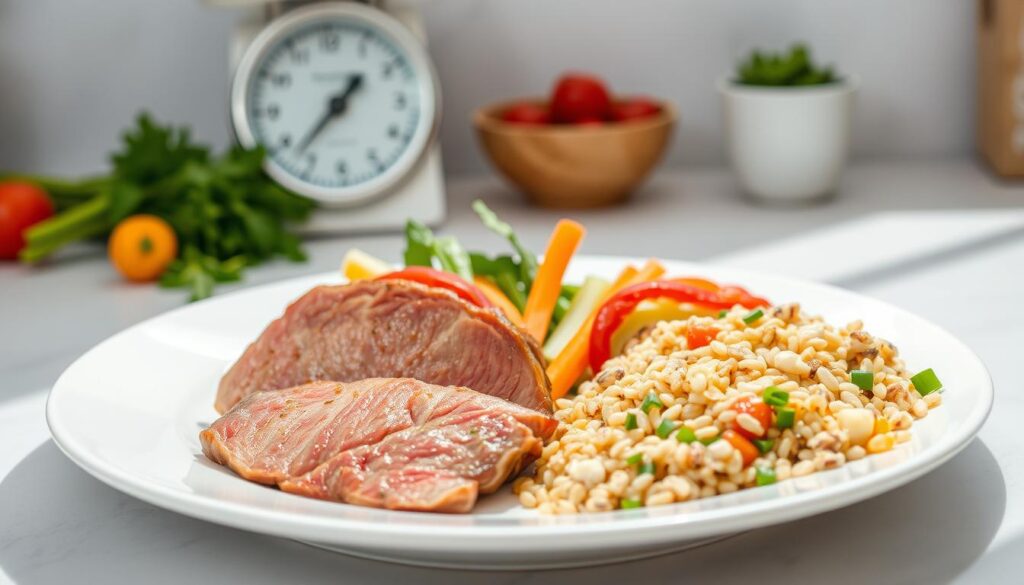
Portion control isn’t about cutting out food. It’s about being mindful and making healthy choices. By mastering mindful eating, you can keep your meat and protein intake right. This supports a healthy and sustainable diet.
Healthy Meat Preparation Methods
Adding meat to a healthy diet matters a lot. The Healthy Eating Food Pyramid shows the importance of good cooking methods. It suggests trimming fat from meat and using low-fat ways like steaming or boiling.
Frying less can also make meat part of a healthy diet. High-heat frying can create harmful substances. These are linked to cancer and other diseases.
Healthier Cooking Techniques
- Simmering, poaching, and stewing meat at lower temperatures can help minimize the production of AGEs and preserve essential vitamins and minerals.
- Panfrying and stir-frying meat at high heat for short cooking times can retain more nutrients and reduce the formation of cholesterol oxidation products compared to other methods.
- Marinating meat with antioxidant-rich mixtures, such as herbs, spices, and citrus juices, can significantly reduce the formation of potentially carcinogenic heterocyclic amines (HAs).
- Slow cooking meat in a crock pot at around 190°F can be a healthy and flavorful cooking method.
Choosing the right oils for cooking is key. Use oils with high smoke points, like extra virgin olive oil. This prevents harmful aldehydes. Adding garlic, ginger, and herbs can also make meat taste great without unhealthy additives.
| Cooking Method | Potential Health Benefits | Potential Drawbacks |
|---|---|---|
| Grilling/Broiling | – Minimal added fat – Retains nutrients |
– Formation of PAHs and AGEs |
| Simmering/Poaching | – Reduced AGE formation – Retains B vitamins |
– Potential loss of some nutrients |
| Panfrying/Stir-frying | – Retains nutrients – Minimal cholesterol oxidation |
– Potential HA formation |
| Deep-frying | – N/A | – High levels of AGEs, aldehydes, and HAs – Increased cancer and heart disease risk |
Choosing better ways to cook meat and using natural flavors can make meat part of a healthy diet. This way, you can enjoy meat while avoiding health risks from certain cooking methods.
Conclusion
Eating a balanced diet is key for good health, and meat is an important part of it. Knowing to eat 2 servings, or 6 oz., of lean meat helps meet nutritional needs. It also lowers the risk of health problems.
Too much red and processed meat can harm your health. It can even increase your chance of dying early or getting type 2 diabetes. But, eating fish, poultry, nuts, legumes, low-fat dairy, and whole grains can help a lot.
Using the palm technique for portion sizes and choosing lean meats are good steps. Also, cooking meat in healthy ways is important. This way, meat can be part of a healthy diet that boosts your health.
Being mindful of how much meat you eat and eating a variety of foods is key. It helps you reach your health goals and live a healthy life.

